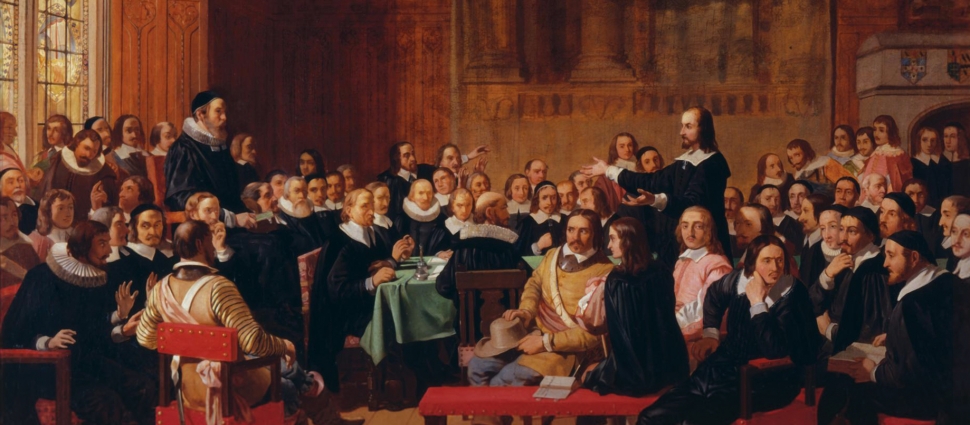The Westminster Confession: Learning from the Past

Is there any use in studying a summary of Scripture that is pushing 400 years of age? Before answering that question let’s think about what the question supposes and what it says about our thinking today. We are suspicious of old things. Of course, not everything older is better. But truth doesn’t change no matter how old. The Christian faith “was once for all delivered to the saints” (Jude 1:3). Picture an ancient treasure map passed down from one generation to the next. Only a fool would think of tampering with the message of the map. And any information previous generations recorded about their understanding of the map would be welcome to those hoping to find the treasure.
Sadly, many Christians no longer think of the faith in this way. Many people now think of Christianity as a story-starter about Jesus that each generation needs to tell in its own way. But the story of redemption doesn’t work like that. The redeeming power of Scripture lies in an accurate and sincere understanding of the story the Bible actually tells. The written word, like the incarnate word is always “unchanged, unchanging … a lantern to our footsteps” which “shines from age to age.”[i] Rather than ignoring how earlier ages were guided by that light we should listen. And especially to reliable historical guides. And the Westminster Confession of Faith is one of the best. At the start of this thirty-three part study it will help to understand how we received this document and what it offers us.
The History of the Westminster Confession of Faith
The Confession of Faith is one of five documents written at the Westminster Assembly of Divines, a ten-year church meeting meant to address social, political, and religious unrest in England following the reformation.
For over a hundred years England had been officially Protestant, mostly, though with much disagreement over what that meant. In 1534 Henry VIII declared himself head of the Church of England. Henry’s successor, Edward VI, helped introduce the Book of Common Prayer and a reformed confession of faith called The Forty-Two Articles (1553; revised to thirty-nine articles in 1563). When Edward died very young his half-sister Mary promoted Roman Catholicism and persecuted reformers. Her successors, Elizabeth I and James I, were moderate Protestants. They rejected both Catholicism and the reform efforts of the Puritans, who pushed for purer Christianity. But under Charles I literal war broke out between the King, who favored a national, Anglican Church, and Parliament which was heavily influenced by the Puritans.
In late 1641, Parliament asked Charles to reform his rule over church and state. Parliament also asked him to call an assembly of the best “divines” or gospel ministers of the nation to give advice for the peace and government of the church. Charles refused. In June 1643, in the midst of the civil war, Parliament itself authorized the Westminster Assembly which was made up of thirty members of Parliament and 121 ministers from every county of the kingdom, along with several outstanding Scottish commissioners.
For nearly six years the assembly met five days a week from morning to afternoon. Every Monday morning each of the sixty to eighty men present renewed their vow to maintain nothing in doctrine or discipline but what is “most agreeable to the word of God” and what “may make most for God’s glory, and the peace and good of this church.” Parliament mandated the assembly to revise the Anglican Thirty-Nine Articles. But when England and Scotland entered into a Solemn League and Covenant the assembly’s mandate changed. It was now to form a new plan for the reformed churches of England, Scotland, and Ireland.
The assembly wrote five important documents called The Westminster Standards: a Form of Presbyterial Church Government, a Directory for the Public Worship of God, two catechism—one larger, one shorter—and a confession of faith. The confession and its catechisms never found a lasting place in the Church of England though they have guided twenty generations of Presbyterians and confessional Baptists. And they can continue to help us today regardless of our church tradition.
The Virtues of the Westminster Confession of Faith
So how can a 400 year-old summary of the faith help us today?
The Westminster Confession is clarifying.
Contemporary evangelicals affirm their commitment to Scripture. But what does that mean? Many people claim to believe the Bible while denying what it teaches, or disobeying its commands. Other sincere Christians simply do not accurately know what Scripture teaches, even concerning its central themes. Among churches that do clarify their beliefs, doctrinal statements are often brief and offer little help actually teaching the faith, a basic requirement in the Great Commission (Matt. 28:19). The confession’s 12,000 words elaborate thirty-three vital topics. Far from usurping Scripture’s authority the confession turns readers back to the Bible. The assembly took almost five months to support every proposition with 2,500 Scripture texts. Like concise driving instructions the confession tells the same story as Scripture—creation, fall, redemption, and consummation—in a way that can help us on our journey to God.
The Westminster Confession is unifying.
The confession’s biblical, reformed theology reveals the tremendous harmony between the various branches of the Protestant Reformation. Similar to how parallel Bibles tell the same story in different languages or translations the confession states biblical truth, like many confessions before it, only in more refined and developed language.[ii] And the confession not only unites believers from various traditions but from every age. It underscores the truth that “the Bible actually teaches things about God which apply in all times and in all places to all people.”[iii] Its antiquity actually helps remind us that the Christian faith is timeless.
The Westminster Confession is invigorating.
The Confession teaches us to fight and how to fight. The Puritan quest for reformation and the work of the assembly should encourage us to take our place in God’s army and “contend for the faith that was once for all delivered to the saints” (Jude 1:3) Our battlefields will differ; we need to pay attention to the particular truths and practices being contested today. But we wear the same armor and wield the same weapons including truth, righteousness, faith, and prayer. We fight, willing to suffer in order to gain a great reward, honor our heritage, and leave a legacy. In the words of the Solemn League and Covenant, let’s endeavor “both in public and private, in all duties we owe to God and man, to amend our lives and each one go before another in the example of a real reformation.” Toward that end the Westminster Confession of Faith can be a great help.
William Boekestein pastors Immanuel Fellowship Church in Kalamazoo, Michigan. He has authored numerous books including, with Joel Beeke, Contending for the Faith: The Story of The Westminster Assembly.
[i] “O Word of God Incarnate,” William Walsham How, Trinity Psalter Hymnal, 171.
[ii] For a great illustration of this reality and an excellent resource for confessional theology see Joel R. Beeke and Sinclair B. Ferguson, ed. Reformed Confessions Harmonized (Grand Rapids: Baker, 1999).
[iii] Chad Van Dixhoorn, Confessing the Faith: A Reader’s Guide to the Westminster Confession of Faith (Carlisle, PA: Banner of Truth, 2014), ix.





